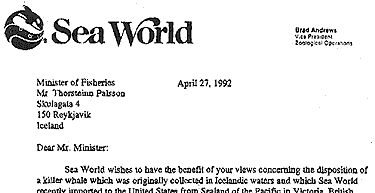

Minister of Fisheries
Mr. Thorsteinn Palsson
Skulagata 4
150 Reykjavik
Iceland
Dear Mr. Minister:
Sea World wishes to have the benefit of your views concerning the disposition
of a killer whale that was originally collected in Icelandic waters and which
Sea World recently imported to the United States from Sealand of the Pacific in
Victoria, British Columbia (Canada). An administrative process now underway in
the United States Department of Commerce could lead to an order for the return
of the killer whale to its point of collection. Sea World believes that this
presents an important and urgent issue. This letter reviews the events
surrounding the importation of the killer whale and describes the relevant
provisions of U.S. law.
On November 7, 1991, Sea World submitted an application to the National Marine
Fisheries Service ("NMFS"), Department of Commerce, for a permit to import
three killer whales, two females and one male, from Sealand of the Pacific for
purposes of public display and captive propagation. At the time of the
application, and prior to its submission, Sea World advised NMFS that at least
one female was pregnant. Sea World further advised NMFS that if the female
successfully delivered a calf it might be necessary to remove the male from
Sealand in order to ensure successful nursing and bonding of the female and
calf.
A calf was successfully delivered on December 24, 1991. After delivery, the
adult male, Tilikum, was forced into a small medical pool by the females and
was confined there. Due to the potential health problems associated with that
confinement and the potential threat to the mother and calf if the male
returned to the main pool and attempted to interfere with the mother or calf,
Sea World applied to NMFS for a temporary emergency permit to import Tilikum.
Sea World applied for a temporary emergency permit because NMFS had not yet
acted upon the permanent permit application. The emergency application was
submitted on January 3, 1992, and was approved on January 8, 1992 whereupon
Tilikum was transported from Victoria to Sea World in Orlando, Florida. Prior
to approval, representatives of the Government of Canada, NMFS, and the U.S.
Marine Mammal Commission observed the situation and concurred with Sea World
that immediate importation of Tilikum was required for his best interest. The
November 7, 1991 application for a permanent permit is still pending at NMFS.
The provisions of the US Marine Mammal Protection Act under which the emergency
permit was granted provide that if it is "feasible" to return the imported
animal "to its natural habitat" then "steps to achieve that result shall be
taken." Although this provision was intended to address the rescue and release
of beached and stranded animals, it was nevertheless incorporated by reference
into the emergency import permit for Tilikum. The permit also stated that if
Sea World's November 7, 1991 application for permanent placement of Tilikum was
disapproved, then NMFS could require Sea World to release Tilikum "at the
original location of capture." Tilikum was collected in 1983 in waters subject
to the jurisdiction of Iceland.
The permit conditions reflect the recommendations of the Marine Mammal
Commission, which stated
[NMFS] should identify what steps (e.g. identification of an area and/or group
of wild animals to which release would be appropriate, authorization under U.S.
and/or foreign law, retraining the animal. monitoring the animal once released,
etc.) would be necessary to effect the return of the whale to Icelandic waters
and determine if such release is feasible.
The Marine Mammal Commission and NMFS apparently believe NMFS has the authority
to compel the return of Tilikum to waters subject to the jurisdiction of
Iceland. Although the existence of such authority is not clear, Sea World
believes any such action would require, at minimum, consultation with and
approval by Icelandic authorities. We assume that approval by the Government of
Iceland would also require its determination that the return is feasible.
Sea World believes a determination of the feasibility requires an analysis of
1) the likelihood that Tilikum will survive if released; 2) the possible impact
of Tilikum's release on the fishing industry, since Tilikum was maintained in a
net enclosure at Sealand and is accustomed to human beings and nets; and 3) the
potential impact of Tilikum's release on the marine environment. The last
mentioned determination would require an in-depth analysis of the incidence and
distribution of disease and disease causing organisms in the fish and marine
mammal populations in Icelandic and Canadian waters, as well as an analysis of
any possible latent pathogens being carried by Tilikum. While at Sealand,
Tilikum was maintained in an ocean pen surrounded by a 500-boat marina and
occasionally consumed fish native to the region. Even with a thorough
examination of Tilikum, it is possible that the presence of some subclinical
organisms not native to Icelandic waters might not be detected.
After considering the available information, Sea World believes it is not
feasible to return Tilikum to Icelandic waters, primarily because Tilikum is
not likely to survive once released. However, Sea World wishes to consult with
the Government of Iceland and obtain its views on these matters, since any such
release would be subject to the laws and jurisdiction of Iceland.

|





